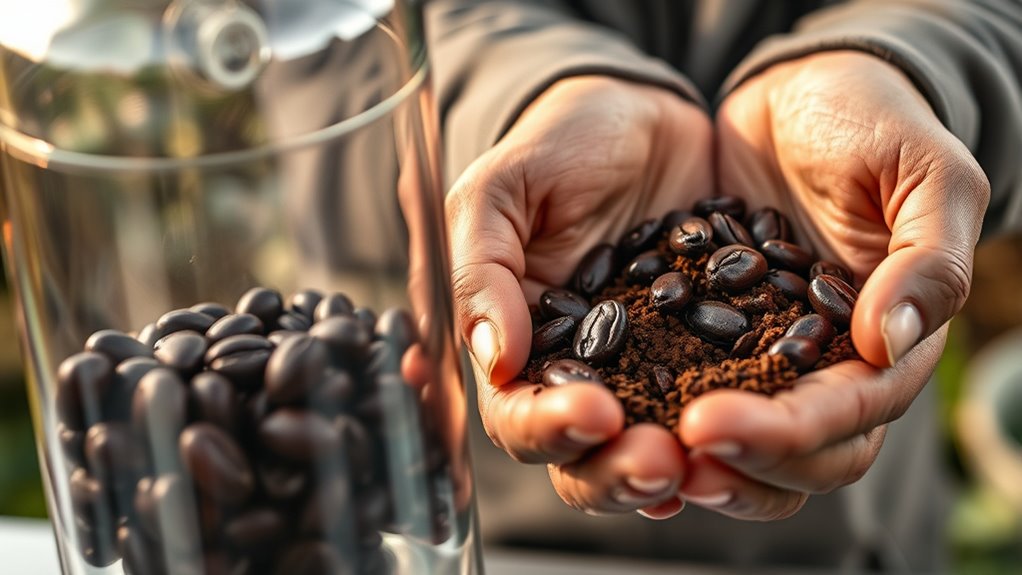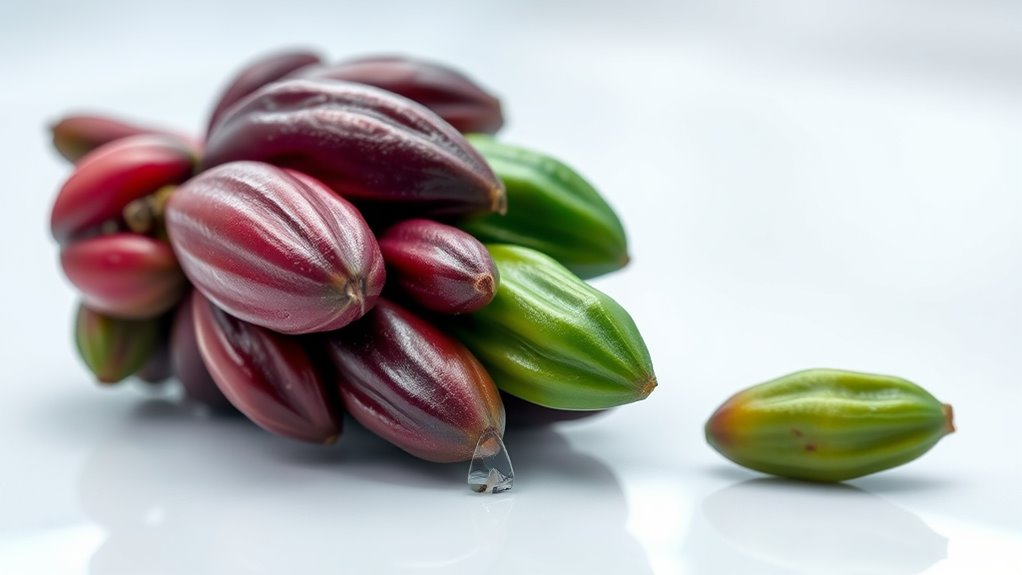Lab-grown chocolate offers farmers a chance to move away from traditional, resource-intensive farming practices that can harm ecosystems and rely on questionable labor conditions. It can create new roles focused on sustainable, laboratory-based work and reduce issues like deforestation and unfair wages. While some farmers may worry about income or land use, plenty of opportunities exist for diversification and retraining. To understand how this innovation could reshape farmers’ futures, explore what lies ahead.
Key Takeaways
- Lab-grown chocolate reduces dependence on traditional cacao farming, potentially impacting farmers’ income and land use rights.
- Farmers may need to diversify into sustainable practices, eco-tourism, or alternative crops to adapt to industry shifts.
- Transition to lab-grown chocolate offers retraining opportunities and new roles within a more ethical, sustainable industry.
- Industry innovations promote fairer labor practices and reduce exploitation issues associated with conventional cacao supply chains.
- Support from governments and organizations is crucial to help farmers navigate industry changes and ensure equitable benefits.

Imagine enjoying your favorite chocolate without worrying about ethical concerns or environmental impact—thanks to lab-grown chocolate, that’s now possible. This innovative approach to chocolate production challenges traditional farming methods, offering a more sustainable and ethical alternative. For farmers, this shift could mean significant changes in how they operate, but it also opens up new opportunities. Instead of relying solely on traditional farming practices, which often involve heavy land use, water consumption, and pesticides, lab-grown chocolate reduces the pressure on natural resources. By cultivating cacao ingredients in controlled environments, producers can minimize deforestation and habitat destruction, aligning with goals of sustainable farming. This approach not only preserves ecosystems but also enables consistent quality and supply, regardless of climate variability or pests, which can devastate traditional crops.
From an ethical sourcing perspective, lab-grown chocolate offers a way to eliminate many of the labor and exploitative issues often associated with conventional cacao farming. Child labor, unfair wages, and unsafe working conditions are persistent problems in some regions where traditional cacao is cultivated. Switching to lab-grown alternatives means that farmers and companies can bypass these problematic supply chains, promoting fairer labor practices. For farmers, this could mean a redistribution of roles within the industry—shifting from small-scale, often vulnerable farmers to skilled technicians and scientists who develop and manage cultivated cacao components in labs. While this may require retraining and adaptation, it also creates new avenues for employment and innovation.
Additionally, advancements in high-quality image reproduction technology allow for more precise control over the production process, ensuring that lab-grown chocolate matches or exceeds the sensory qualities of traditional varieties. However, the shift isn’t without its challenges. Traditional farmers might worry about losing income or land use rights as the demand for lab-grown chocolate rises. Yet, this change could also present opportunities for diversification. Farmers could pivot towards sustainable farming practices that complement lab-grown initiatives, such as growing alternative crops or engaging in eco-tourism and local food markets. Governments and organizations can support this transition by providing resources, training, and infrastructure to help farmers adapt and thrive in a changing landscape.
In the end, lab-grown chocolate isn’t just about satisfying your sweet tooth; it’s about reimagining an industry rooted in ethical and sustainable principles. For you as a consumer, it means enjoying chocolates made with a clear conscience, knowing that the impact on the planet and the people involved was minimized. For farmers, it offers a chance to participate in a cleaner, fairer, and more resilient food system—one that balances tradition with innovation, and environmental responsibility with economic opportunity.
Frequently Asked Questions
How Does Lab-Grown Chocolate Impact Traditional Cocoa Farming Communities?
You might wonder how lab-grown chocolate affects traditional cocoa farming communities. It causes socioeconomic shifts, potentially reducing demand for farm-produced cocoa and threatening farmers’ livelihoods. This shift can also lead to cultural impacts, as communities lose their farming traditions and identities tied to cocoa cultivation. You may see changes in local economies and social structures, highlighting the need to balance innovation with support for those whose lives depend on cocoa farming.
Are There Any Health Differences Between Lab-Grown and Farm-Grown Chocolate?
Like the myth of Icarus soaring high, your curiosity about health implications and nutritional comparison between lab-grown and farm-grown chocolate takes you to new heights. Generally, lab-grown chocolate offers similar nutritional value, with potential for fewer contaminants and additives. While the core health benefits remain comparable, some subtle differences might exist, like lower pesticide residues in lab-grown options. Overall, both provide the pleasure and nutrition you seek, but always check labels for specific details.
What Are the Environmental Benefits of Lab-Grown Chocolate Compared to Traditional Methods?
You’ll find that lab-grown chocolate offers significant environmental benefits over traditional farming. It promotes sustainable practices by using fewer resources and reducing land use. Plus, it helps cut pollution, as it generates less waste and emissions during production. This innovative approach preserves ecosystems and conserves water, making it a more eco-friendly option. By choosing lab-grown chocolate, you support a greener future with less environmental impact.
Will Lab-Grown Chocolate Be More Affordable Than Conventional Chocolate?
Imagine a chocolate bar that’s as affordable as a sunny day—lab-grown chocolate could make that a reality. As production costs decrease with advancements, you’ll likely find lab-grown options more budget-friendly than traditional chocolate. The cost comparison suggests that, over time, lab-grown chocolate will be cheaper because it sidesteps expensive farming and harvesting. So, you might soon enjoy your favorite treat without stretching your wallet.
How Will Lab-Grown Chocolate Influence Global Cocoa Supply and Pricing?
You might see lab-grown chocolate impact global cocoa supply and pricing by enhancing market stability and shifting trade dynamics. As lab-grown options become more prevalent, they could reduce reliance on traditional cocoa farming, lowering prices and stabilizing supply chains during shortages. However, this shift might also challenge existing trade relationships, prompting farmers and traders to adapt. Overall, your experience in the market could change as new alternatives influence prices and availability.
Conclusion
As lab-grown chocolate emerges, remember it’s like a seed planted in new soil—full of promise but also uncertainty. While it symbolizes innovation and progress, it challenges farmers to adapt and find new roots. Embrace this change as a chance to cultivate resilience and creativity. Just as a tree sheds old leaves to grow anew, the industry can transform, ensuring that the rich legacy of chocolate continues to thrive in a future shaped by both tradition and technology.









